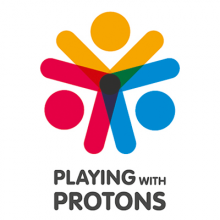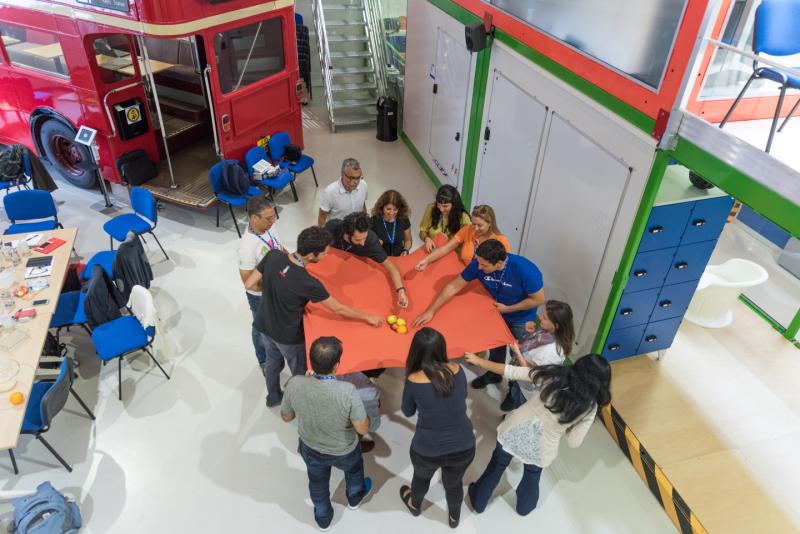
Hosted by OSOS , contributed by Anonymous (not verified) on 8 May 2019
Playing with Protons represents a novel science education initiative led by the CMS Experiment at CERN that is aimed at nurturing and promoting creativity, science motivation and aspirations among K-6 students. It focuses on learning resources communities of interest and ideas student projects and supports in schools in carrying out such projects (especially those that serve students from remote or relatively disadvantaged communities).

Playing with protons aims at enriching teachers’ pedagogical practice with creative, hands-on methodologies through which K-6 students can, in turn, get engaged effectively with science, technology and innovation. Students become familiar with big ideas and latest discoveries in particle physics mainly through hands-on experimentation with everyday materials. The educational approach promotes inquiry, creativity and collaborative learning.
RRI Principles
One of the key aspects of OSOS is the inclusion of RRI - Responsible Research and Innovation principles in innovative pedagogical practices. RRI principles are addressed in the "Playing with Protons " accelerator:
|
Governance |
Playing with protons offers an inclusive and creative approach to science education, one that offers the opportunity to rethink and remodel the field (science education) by achieving changes at the policy level as well. |
|
Public engagement |
Playing with Protons, given that it was conceived as a partnership between various educational stakeholders, namely schools, the Greek Ministry of Education, CERN, EU-funded initiatives, the Ogden Trust, promotes public engagement and wishes to incorporate school projects that involve local community, especially parents |
|
Gender equality |
A range of Playing with Proton activities address the issue of gender equity in science, especially in tackling the image of the “male mad scientist” |
|
Science Education |
The Playing with protons accelerator supports students in developing their problem-solving skills and in participating in important science inquiry activities, as they are asked to place themselves in the shoes of astronomers, astronauts, cosmologists, etc. |
|
Ethics |
The playing with protons approach address issues such as the role of scientific in society and strives to change the image and misconception by delivering school projects that bring CERN and its legacy in primary education. A number of activities tackle major ethical issues such why we need to trust scientific knowledge and it pioneers. |
|
Open Access |
This accelerator promotes the use of open online content, tools and ideas in an effort to reach as further as possible by spreading the message of high energy science and innovations that have been |
|
Stakeholders Participation The accelerator offers an excellent opportunity to attempt to turn the school in to a hub for scientific knowledge transfer. In particular, schools with the support from local stakeholders, such as science centres, museums, companies, individual experts and event CERN itself, could organise events in which the students assume the role of experts informing the public on scientific breakthroughs, on what science and CERN in particular has done for us (the discovery of MRI or the Web, for example) on busting myths. Projects that are being created from this accelerator could focus on guiding students in becoming researchers themselves, designing and organising such an event or campaign. |
Feel
Empirical research suggests that students’ aspirations of pursuing a career in STEM fields, including physics, are likely to be shaped considerably by their experiences of and attitudes to school science at primary level (e.g. Tai et al., 2006). Yet the majority of interventions currently target secondary school settings (Archer, 2013). As a response, Playing with Protons represents a novel science education initiative led by the CMS Experiment at CERN that is aimed at nurturing and promoting creativity, science motivation and aspirations among K-6 students. The focus will be on activities in schools (https://playprotons.web.cern.ch/)
Session 1: What do scientists do? Introduce your classroom to the fundamentals of scientific inquiry. Check out related activities in these two communities: https://portal.opendiscoveryspace.eu/en/community/playing-protons-uk-847604 & https://portal.opendiscoveryspace.eu/en/community/playing-protons-greece-845642
Session 2: This is an introductory session aiming at explain the fundamentals of particle physics. Here is a relevant resource: https://www.symmetrymagazine.org/particle-physics-abcs/

photo by Anastasia Lafara
Session 3: Facts & Big discoveries at CERN: https://www.weforum.org/agenda/2016/09/7-things-you-didn-t-know-about-cern-and-the-strange-world-of-particle-physics-c362a466-43a1-449d-9719-9e9d97e6a293/ & https://www.livescience.com/48052-cern-anniversary-big-discoveries.html
Session 4: Find out what CERN has done for you. Consider discussing all the things that have been invented at CERN: https://www.businessinsider.com/why-is-the-lhc-important-2015-5
Imagine
The project rests on the idea that learning science can be a self-fulfilling activity that may create strong personal interest in and engagement with big ideas in particle physics and related domains. Playing with Protons provides an opportunity for students to use their imaginative thinking to co-create new ideas, concepts and forms that train their minds and hands simultaneously. At the same time, its activities are structured around the CREATIONS features, the RRI aspects and the IBSE features. In addition, the activities allow space for pupils of various abilities to participate and contribute their distinctive skills. Importantly, it promotes diversity and attempts to break gender stereotypes about the role of women in science and technology.

photo by Ioanna Kasampa
In this context students are asked to explore (under the guidance of their teachers) ideas and projects that are related to both their curriculum and things happening at CERN.
- In particular students should look into aspects of scientific discovery either through the use of activities that can be found here https://portal.opendiscoveryspace.eu/en/search-resources-in-community/847604 and here https://portal.opendiscoveryspace.eu/en/search-resources-in-community/845642
- Students maybe guided to build various models of CERN, our solar system, a lab, etc.
Students may also start working on ideas that try to link local or global problems such as pollution and other environmental challenges, diseases, employment, lack of knowledge about scientific matters, stereotypes on gender and science and more.
Create
Session 1: Cosmology (4 didactic hours; at least 1 didactic hour should be devoted to hands-on experimentation). By the end of this session, students are expected to understand:
• What is the Universe made of?
• How does the Universe evolve?
• Why is the Universe so big and old?
• How do we know the age of the Universe?
• How does light travel across the Universe and why does it appear in our eyes in various colours?
• How many dimensions does the Universe have?
• How do galaxies move within the Universe?
• Who were the first scientists who helped us understand how and why the Universe expands?
• What scientific experiments are currently carried out to help us understand better what is the Universe made of?
Session 2: Elementary Particles (4 didactic hours; at least 1 didactic hour should be devoted to hands-on experimentation). By the end of this session, students are expected to understand:
• What are the basic constituents of matter?
• What is the structure of the atom?
• How small is the atom and its basic constituents?
• Who were the scientists who discovered the atom and its basic constituents?
• What is the difference between hadrons and leptons?
• What are the fundamental forces in nature by which matter is effected?
• What is the Standard Model in particle physics?
• How do particles acquire their mass?
• How can scientists at CERN discover new particles?

Session 3: An Introduction to CERN: Past, Present and Future (4 didactic hours; at least 1 didactic hour should be devoted to hands-on experimentation). By the end of this session, students are expected to understand:
• What does the acronym CERN stand for?
• When, how and why was CERN established?
• What kind of research is carried out at CERN?
• How many countries do take part in CERN’s experiments?
• Why are there so many physicists and engineers at CERN? Are there other professions involved in CERN?
• What is the Large Hadron Collider?
• What are the main LHC experiments and what do they study?
• What are the important scientific discoveries made at CERN?
• What does the future behold for the experiments at CERN?
Session 4: Accelerators and Detectors at CERN and their Technological Applications (4 didactic hours; at least 1 didactic hour should be devoted to hands-on experimentation).
By the end of this session, students are expected to understand:
• How does a particle accelerator work?
• How many particle accelerators do exist at CERN and what are the main differences between them?
• Why do scientists smash protons with each other at the LHC?
• How do scientists detect the results of particle collisions at the LHC?
• What are the main components of a particle detector and why are particle detectors at CERN so big?
• Why are the LHC and the particle detectors built underground?
• What kind of scientific data do scientists retrieve from the LHC experiments and how do they perform their analyses?
• In what ways do the experiments at CERN benefit our everyday life?
• What are the most important technological applications of CERN for society?
Session 5: Creativity Zone (4 didactic hours)
This session builds on the knowledge that students have acquired in the previous 4 sessions. During the “creativity zone” session, the students work in groups, each of which selects a topic of interest (e.g. particle detectors). The challenge for students is to demonstrate and communicate in hands-on and creative ways, through model making, play gaming, drawings, music, dance performances or sketches, their understanding, knowledge and interpretation of the scientific phenomena, ideas and discoveries that were introduced to them during the previous four sessions.
Following the sessions here is a list with ideas on types of projects that can come out this accelerator:
- Democracy (scientific collaboration). Work on what does it take to produce high quality science. Attempt to tackle misconceptions about lone wolfs, etc.
- Students as trainers on science fighting anti-science theories. Turn your students into agents of scientific knowledge and truth. Organise events that students demonstrate such truths. Share this approach with local schools, parents, etc. Involve a local stakeholder in the process (science centres, museums, companies, etc.)
- Using CERN ideas to address local environmental issues. Again attempt a more thorough link at the level of student research into science and solutions to local problems.
- Art meeting science. Create projects that combine the use of science and art. Plenty of ideas in the two Playing with Protons Communities
- Why research matters
- Girls and scientific careers
Check the Playing with Protons demonstrator again
https://portal.opendiscoveryspace.eu/en/edu-object/playing-protons-demonstrator-848337
